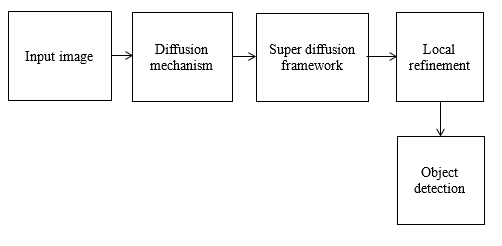- ALL COMPUTER, ELECTRONICS AND MECHANICAL COURSES AVAILABLE…. PROJECT GUIDANCE SINCE 2004. FOR FURTHER DETAILS CALL 9443117328


Projects > ELECTRONICS > 2020 > IEEE > DIGITAL IMAGE PROCESSING
One major branch of saliency object detection methods is diffusion-based which construct a graph model on a given image and diffuse seed saliency values to the whole graph by a diffusion matrix. While their performance is sensitive to specific feature spaces and scales used for the diffusion matrix definition, little work has been published to systematically promote the robustness and accuracy of salient object detection under the generic mechanism of diffusion. In this work, we firstly present a novel view of the working mechanism of the diffusion process based on mathematical analysis, which reveals that the diffusion process is actually computing the similarity of nodes with respect to the seeds based on diffusion maps. Following this analysis, we propose super diffusion, a novel inclusive learning-based framework for salient object detection, which makes the optimum and robust performance by integrating a large pool of feature spaces, scales and even features originally computed for non-diffusion-based salient object detection. A closed-form solution of the optimal parameters for the integration is determined through supervised learning. At the local level, we propose to promote each individual diffusion before the integration. Our mathematical analysis reveals the close relationship between saliency diffusion and spectral clustering. Based on this, we propose to re-synthesize each individual diffusion matrix from the most discriminative eigenvectors and the constant eigenvector (for saliency normalization). The proposed framework is implemented and experimented on prevalently used benchmark datasets, consistently leading to state-of-the-art performance.
Contrast-based methods
Through eigen-analysis of the diffusion matrix, we find that: 1) the saliency of a node (called focus node) is equal to a weighted sum of all the seed saliency values, with the weights determined by the similarity in diffusion map between the focus node and each seed node, and 2) since the diffusion map is formed by the eigenvectors and eigenvalues of the diffusion matrix, the process of saliency diffusion has a close relationship with spectral clustering. This novel interpretation provides the foundation for the novel framework and methods proposed in this work. We propose an inclusive and extensible framework, named super diffusion, for salient object detection, which computes the optimal diffusion matrix by exploiting a pool of feature spaces, scales and even saliency features originally computed for non-diffusion-based salient object detection. The parameters for the optimal integration are derived in a closed-form solution through supervised learning. This contrasts with traditional diffusion-based methods that define the diffusion matrices and seeds with high specificity, compromising the robustness of performance. We propose to promote each individual saliency diffusion scheme prior to its integration into the overall super diffusion framework. Based on the close relationship between saliency diffusion and spectral clustering, the promotion is achieved by re-synthesizing an individual diffusion matrix from the most discriminative eigenvectors and the constant eigenvector (for saliency normalization). In addition, we propose efficient and effective ways to compute seed vectors based on background and foreground priors.
BLOCK DIAGRAM
